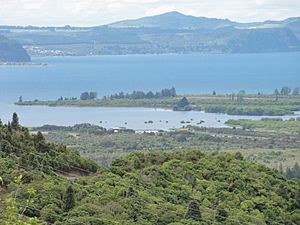Lakes of New Zealand facts for kids

New Zealand is a country filled with amazing natural beauty, and its lakes are a big part of that! There are over 3,820 lakes in New Zealand that are bigger than a hectare (about the size of a rugby field). These lakes formed in many different ways, making each one special.
Many lakes in the central North Island were created by volcanoes. These are often called crater lakes because they sit in the bowls of old volcanoes. If you travel to the Southern Alps, you'll find most lakes there were carved out by huge sheets of ice called glaciers long ago. New Zealand also has many lakes made by people. These are often called hydroelectric reservoirs and are used to create electricity. You can find many of these along the Waikato River and in places like South Canterbury and Central Otago.
Contents
How New Zealand's Lakes Formed
New Zealand's lakes have fascinating stories about how they came to be. Their formation depends a lot on the land around them.
Lakes from Volcanoes
In the North Island, especially around the central areas, you'll find many lakes that are actually old volcano craters filled with water. When a volcano erupts and then collapses, it can leave a big bowl-shaped hole. Over time, this hole fills with rainwater, creating a beautiful lake. Lake Taupō, for example, is a massive volcanic lake.
Lakes from Glaciers
The South Island, with its towering Southern Alps, is home to many lakes carved by glaciers. Thousands of years ago, huge glaciers slowly moved across the land. As they moved, they scraped away rock and soil, creating deep valleys. When the climate warmed, these glaciers melted, and the valleys filled with water, forming long, deep lakes like Lake Wakatipu or Lake Te Anau.
Lakes Made by People
Not all lakes are natural. Many lakes in New Zealand were created by people to help generate electricity. These are called hydroelectric reservoirs. Engineers build large dams across rivers, which then hold back the water, forming a lake behind the dam. The water is then released in a controlled way to spin turbines and make electricity. The Waikato River has several of these man-made lakes.
Cool Facts About New Zealand's Lakes
New Zealand's lakes hold some impressive records!
- Largest Lake: The biggest lake in New Zealand is Lake Taupō. It covers a huge area of 616 square kilometers (about 238 square miles)!
- Deepest Lake: The deepest lake is Lake Hauroko. It plunges down to an incredible 462 meters (1,516 feet) deep! That's taller than many skyscrapers.
New Zealand has:
- 41 lakes that are larger than 10 square kilometers (1,000 hectares).
- 229 lakes that are bigger than 0.5 square kilometers (50 hectares).
- 3,820 lakes that are larger than 0.01 square kilometers (1 hectare).
Protecting Our Lakes
Keeping New Zealand's lakes healthy is super important for everyone. Scientists use a special tool called a trophic level index to check how clean and healthy a lake is. It helps them understand if a lake has too many nutrients, which can be a sign of pollution.
Based on studies of 134 lakes, it's thought that about one-third of New Zealand's lakes have high levels of nutrients. This means they might have too much "food" for tiny plants called algae, which can grow too much and make the water cloudy or green. This can harm the fish and other creatures living in the lake. Protecting our lakes means making sure they stay clean and clear for future generations to enjoy!


